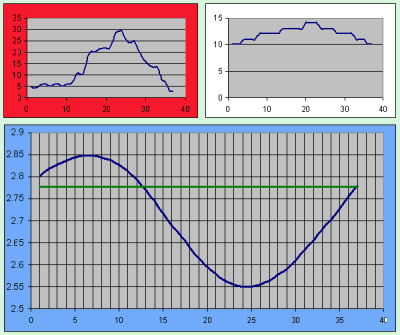Nothing is random, it might be the truth, but can we take advantage of it?
On a levelled roulette wheel with basics definitely not, but let’s look what our chances on a tilted wheel or the wheel with common drop point are.
Systems as Genuine Winner expect that dealer continually spins 15-18 rotations and that rotor is constant therefore we can’t know where the ball will hit the rotor. We can only say yes, it will be at some positions more often than at the others. Defining where to place chips based on from where the dealer picks up the ball isn’t brilliant start at all. He can pick up the ball and spin it within 0.5 sec, next time it can be 1 sec etc. He may spin it once 15 rotations next time 18 or anything in between or even out of targeted limits. Such fastball at the spins start, we only wouldn’t be able to estimate within three rotations of accuracy.
An additional problem is a rotor. If dealer spins it faster only one pocket per second and if the spin is 15 sec long it will create 15 pockets error. And finally, not all spins will hit the dominant diamond. If we get 70 %, I would say it is a perfect condition. But that means even if we have 100% accurate prediction 30% of spins will be wrongly predicted.
Anyway, let’s say if there is somewhere an average of averages.
The white chart is showing such possible case where at some positions we do have higher hits rate. Now if on top of it we apply probability of scatter law (red graph) we get a result as displayed on the blue graph.
(By the way, the blue graph always displays the result of data as if we played 100spins.)
Anything above green line is an advantage. If we read values we can see that pick point is only 2.85 and green line is at 2.78 so the difference is 0.07. It means that for every 100 spins played we would win 35×0.07=2.45 units. Or if we round it up, we can say every 200 spins we should profit three units. Theoretically, it will work; you can play for 10 hours and win few bucks.
The problem is that hit rate is only 0.07 above the advantage limit. Therefore, we wouldn’t be able to detect it. It will take hours to define it, but until then definitely, the dealer will change. He may start spinning more often the slightly different amount of rotations. The ball could be replaced, or it could pick some dirt or hand cream from dealers, polish on the wheel may erode, temperature or air pressure will change, the wheel will slightly move from vibrations on the table, the tilt will change etc.
On some dominant drop zone wheels, with proper VB technique or the FF tilted system, and decent ball jumps scatter it may be possible to get 1-2 extra hits per 100 spins. So compare 2.00 with 0.07. It is huge difference. Whoever seriously played roulette would know that even with significant advantage defining pick point is not an easy task at all. So how someone can find it when the pick point is 30 times smaller?
Also, conditions on the wheel are changing, and advantage player can notice them because he knows expected drop point. Defining pick point that is 0.07 above limit is mission imposable.
There is much irony in the world of roulette. I am selling a device which precisely makes a prediction based on the ball and rotor speed. So there is no estimation at all. The price is three times lower then paper system some vendors are offering. But they still comment well it isn’t good because it doesn’t have a built-in graph. For them, the device which can produce 2.0 above the line isn’t even good as their paper system which can only theoretically produce 0.07. Reality is that building roulette scatter graph with additional accessories while playing is useless.
You can read more about this subject at Forum

Recent Comments